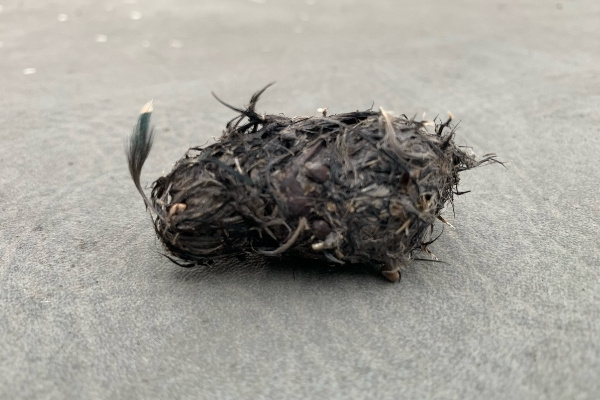I was cleaning up the yard and found an elongated oval object that at first looked like something the neighbor’s dog deposited under the maple tree. Closer examination revealed that it was an owl pellet. These are fascinating objects, especially if you’ve never found one. Owls typically swallow their prey whole. Later, while roosting, they regurgitate feathers, fur and bones from whatever they’ve been eating. Biologists and other strange people like to study these, as they give clues about the diets of the owls in a particular area. Since birds don’t “chew” their food, the bones, teeth, jaws, feathers and even entire skulls remain relatively intact. The kinds and species of animals the owl ingested can thus be determined by dissecting the pellet. If you’re interested, you can purchase owl pellets on the internet. I think it’s a lot more ‘fun’ to find them myself under large trees where I suspect an owl may have been roosting.
Later, while roosting, they regurgitate feathers, fur and bones from whatever they’ve been eating. Biologists and other strange people like to study these, as they give clues about the diets of the owls in a particular area. Since birds don’t “chew” their food, the bones, teeth, jaws, feathers and even entire skulls remain relatively intact. The kinds and species of animals the owl ingested can thus be determined by dissecting the pellet. If you’re interested, you can purchase owl pellets on the internet. I think it’s a lot more ‘fun’ to find them myself under large trees where I suspect an owl may have been roosting.
What I find remarkable, and have yet to figure out, is how owls (and certain other birds) manage to do this! When a bird swallows food, it first enters the gizzard where it is ground up before continuing on through the digestive process. Apparently, the owl’s gizzard is somehow able to ‘sort out’ the undigestible parts from the soft flesh. Think about it – a muscular organ designed to grind up food can sort out the good from the bad! Yes, I’m one of those strange biologist types who ponder these things. This one really has me baffled, and once more causes me to marvel at the wonders of Creation.


Leave A Comment